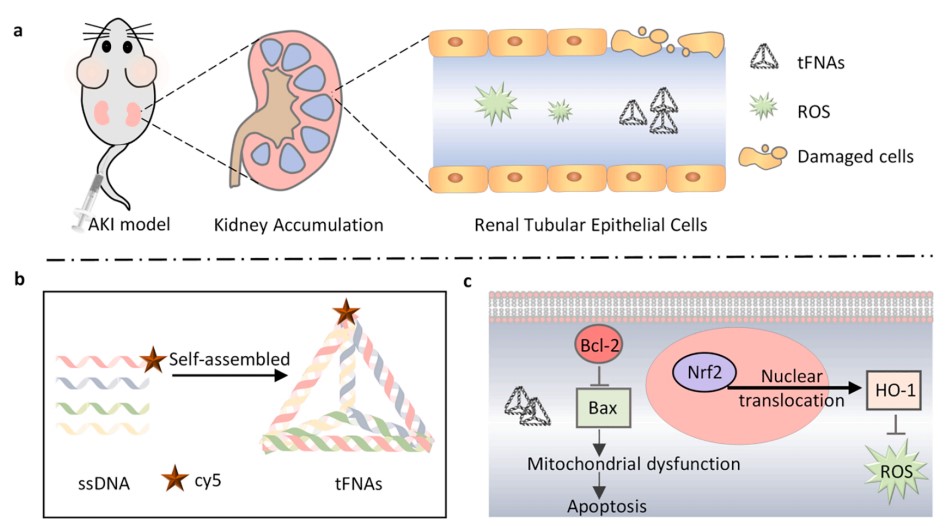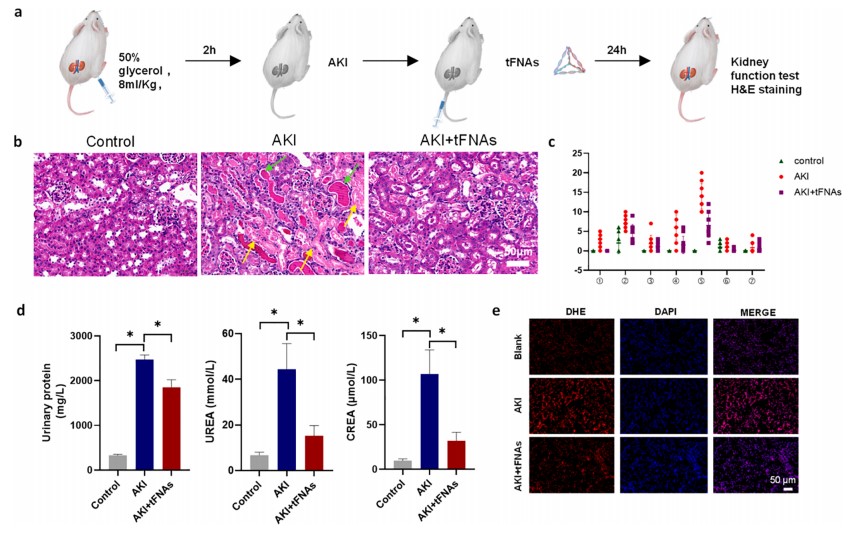The Application of Tetrahedral Framework Nucleic Acids in the Preparation of Drugs for Treating Kidney Injury
2024-06-26
Background:
The kidneys are crucial organs for excreting metabolic waste from the body. Mechanical forces and exogenous compounds (e.g., gentamicin, contrast agents, cisplatin, lipopolysaccharides, glycerol) can directly or indirectly damage the renal tubular epithelial tissue, leading to renal injury and posing severe threats to health and even life.
Indirect damage to renal tubular epithelial tissue refers to situations where mechanical forces or exogenous compounds affect tissues or organs outside the kidneys, causing a sudden increase in certain substances in the blood or the production of new substances (excluding the drugs themselves). This, in turn, damages the renal tubular epithelial tissue. For example, acute kidney injury (AKI) resulting from rhabdomyolysis (RM). The mortality rate of AKI caused by RM can be as high as 20%–50%, and current treatment methods are still underdeveloped. The primary treatment method for renal injury is continuous renal replacement therapy (CRRT), which involves continuously and slowly removing fluids and solutes through extracorporeal blood purification techniques. Although its efficacy is acknowledged, the timing of intervention, treatment models, and dosages remain controversial. Few drugs have been discovered for treating renal injury, and those available often have significant side effects, leading to numerous limitations in their application. Antioxidants play a role in early intervention in the pathogenesis of renal injury by reducing oxidative damage to injured kidneys. Developing safe and effective reactive oxygen species (ROS) scavengers for AKI treatment remains an area of exploration.
Cutting-Edge Research: Tetrahedral Framework Nucleic Acid for Renal Injury Treatment
Tetrahedral DNA (TDN), also known as tetrahedral framework nucleic acids (tFNAs), is a novel DNA nanomaterial consisting of a tetrahedral structure formed by the self-assembly of four single-strand DNA molecules through denaturation and renaturation with base complementary pairing. It is easy to synthesize, highly biocompatible, and commonly used as a carrier for certain drugs.
While the exact mechanism of ROS generation in AKI is not yet determined, reducing ROS production and alleviating oxidative damage are considered potential therapeutic approaches. DNA is a naturally occurring polymer that not only carries genetic information but also functions as an ordered, controllable framework nucleic acid. Among all types of DNA nanostructures, tetrahedral framework nucleic acids (tFNAs) are receiving increasing attention. Studies have shown that tFNAs exhibit significant antioxidant properties in RAW264.7 cell lines, suggesting their potential as antioxidants for AKI treatment. Here, we propose tFNAs as a drug for treating renal injury caused by rhabdomyolysis (RM-AKI).
Research Methods:
Synthesis of tFNA was identified using methods such as TEM and PAGE.
Antioxidant capacity of tFNA was assessed using CCK-8, ROS staining, and qPCR.
Anti-apoptotic ability of tFNA was evaluated using flow cytometry, mitochondrial staining, and qPCR.
Renal clearance characteristics of tFNA were demonstrated through small animal imaging and renal tissue staining.
Effectiveness of tFNA in RM-AKI treatment was validated using animal models.
Experimental Results:
The technical team synthesized and identified tFNAs as a drug for treating RM-induced AKI. tFNAs were assembled from four specially designed single-strand DNA molecules through base complementary pairing. tFNAs showed significant targeting and accumulation in mouse kidneys. Both in vitro and in vivo experiments demonstrated that tFNAs had a significant therapeutic effect on AKI models. tFNAs significantly alleviated renal damage by inhibiting apoptosis and reducing oxidative stress. At the molecular biology level, tFNAs upregulated the anti-apoptotic protein Bcl-2, downregulated the pro-apoptotic protein Bax, and reduced mitochondrial dysfunction. The Nrf2/HO-1 axis was involved in the process of tFNAs alleviating oxidative stress.
Research Conclusion:
tFNAs primarily protect cells by alleviating oxidative stress and inhibiting apoptosis. These characteristics greatly enhance renal enrichment and reduce renal damage in AKI models. Our research results indicate that tFNAs exhibit excellent antioxidant efficiency, structural stability, preferential renal enrichment, and good biocompatibility, making them a promising new class of antioxidant nanomaterials for AKI treatment.
Published Paper:
Chemical Engineering Journal. 2021, 127426, IF=13.3 DOI:10.1016/j.cej.2020.127426
![]() Tetrahedral framework nucleic acids act as antioxidants in acute kidney injury treatment
Tetrahedral framework nucleic acids act as antioxidants in acute kidney injury treatment




